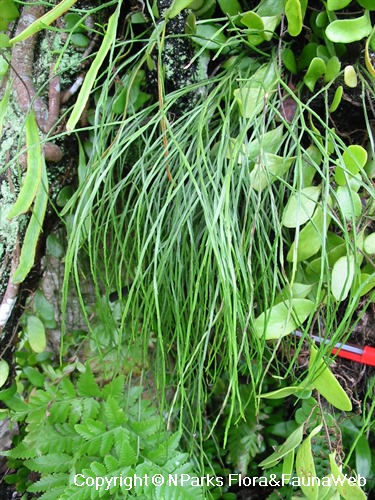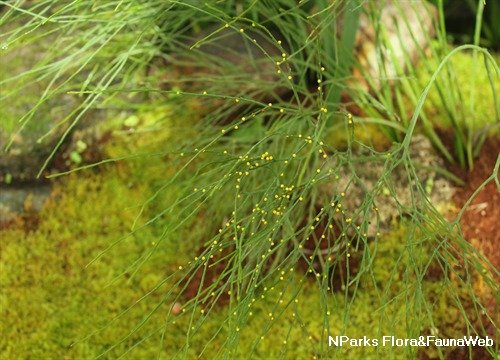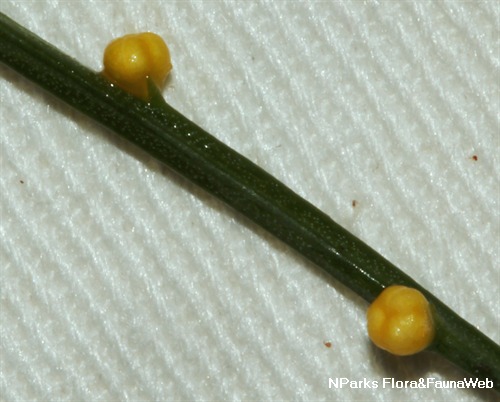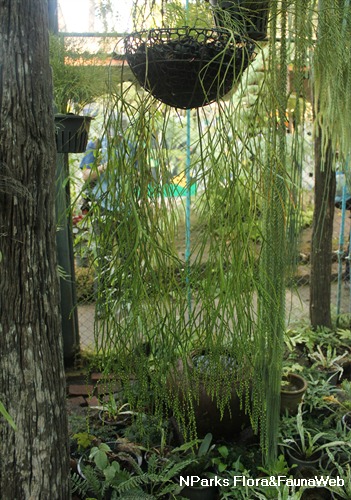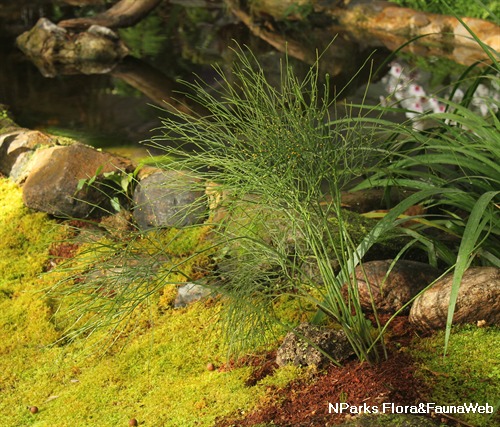
Back
Psilotum nudum (L.) P.Beauv.
| Family Name: | Psilotaceae |
| Common Name: | Skeleton Fork Fern, Whisk Fern, 松叶蕨 |
Name
Classifications and Characteristics
| Plant Division | Ferns & Lycophytes (Non-Seed Vascular Plants) (Whisk Fern) |
|---|---|
| Plant Growth Form | Epiphyte, Lithophyte |
| Lifespan (in Singapore) | Perennial |
| Mode of Nutrition | Autotrophic |
Biogeography
| Native Distribution | America, Japan, Australia, New Zealand, Singapore |
|---|---|
| Native Habitat | Terrestrial |
| Preferred Climate Zone | Tropical, Sub-Tropical / Monsoonal, Temperate |
| Local Conservation Status | Native to Singapore (Least Concern (LC)) |
Description and Ethnobotany
| Growth Form | Erect, fern-like plants, growing up to about 20 - 50 cm long, and dichotomously forked. |
|---|---|
| Roots | Branched rhizomes, usually clumped together. |
| Foliage | Foliage reduced to small scale-like leaves, measuring about 1 - 2.5 mm long, absence of venation pattern. |
| Stems | Yellowish-green stems, much branched towards the tip and triangular in section, measuring about 4 - 5 mm in diameter. |
| Reproductive Parts - non-flowering plant | Yellow sporangia 3-lobed, measuring about 2 - 3 mm wide, on axils of leaves and more prominent on upper stems. |
| Habitat | Can be found occurring on rock crevices, swamps and rocky slopes. |
| Etymology | Psilotum comes from the Greek word psilos, which means smooth and referring to the smooth stems. nudum comes from the Latin word nudus, which means naked and referring to the naked character of the stems. |
| Ethnobotanical Uses | Medicinal: Can be used to treat constipation and respiratory problems. |
Landscaping Features
| Desirable Plant Features | Ornamental Foliage |
|---|---|
| Landscape Uses | Container Planting |
Fauna, Pollination and Dispersal
| Seed or Spore Dispersal | Abiotic |
|---|
Plant Care and Propagation
| Light Preference | Semi-Shade |
|---|---|
| Water Preference | Moderate Water |
| Plant Growth Rate | Moderate |
| Rootzone Tolerance | Moist Soils, Well-Drained Soils |
| Propagation Method | Spore, Division |
Foliar
| Mature Foliage Colour(s) | Green |
|---|---|
| Foliar Modification | Scale-like |
Non - Foliar and Storage
| Root Symbiosis | Fungal Mycorrhiza |
|---|---|
| Root Symbiosis Remarks | Forms a relationship with an endophytic mycorrhizal fungus as absorbing nutrients and water through rhizomes is not efficient. |
Image Repository
Others
| Master ID | 269 |
|---|---|
| Species ID | 1565 |
| Flora Disclaimer | The information in this website has been compiled from reliable sources, such as reference works on medicinal plants. It is not a substitute for medical advice or treatment and NParks does not purport to provide any medical advice. Readers should always consult his/her physician before using or consuming a plant for medicinal purposes. |

